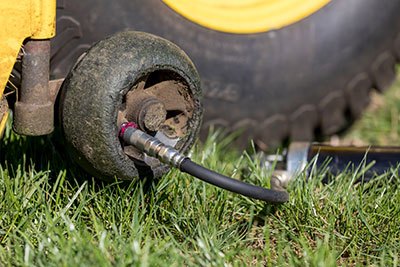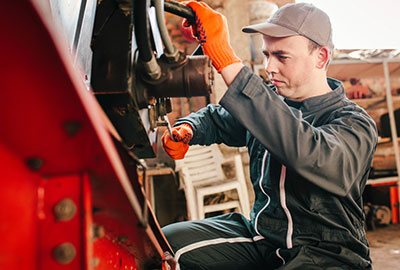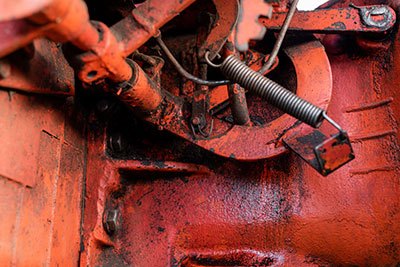If you work in agriculture, you know that the success of your farm or business is dependent upon having reliable machinery. As a farmer, you understand the importance of proper maintenance.
However, knowing when and how often to grease your tractor can be difficult with all the different types of components and varying manufacturing guidelines.
With this guide, you’ll learn about best practices for greasing your tractor so it will run properly throughout the year!
Table of Contents
Take Away Key Points:
- Always remove the old grease before adding a new one to ensure better maintenance. Excess liars will collect dust and dirt, making conditions hard for work.
- Follow the manufacturer’s instructions to oil zerks, fitting, bearing, joint parts, and other elements. Ensure you lubricate your tractors every eight hours of continual use.
- You can use grease guns to apply the oils and decide the right amount to prevent overdoing it, and prolong the tractor’s life.
Best grease fittings for advanced operating conditions
You must grease your farm equipment so it lasts longer and ensure the best consistency of all components, easily your tractor.
But, how often should you grease the equipment, and how to keep the proper maintenance, learn below.
How often should you grease your high-torque machinery?

Greasing your tractor is an important part of regular maintenance and should be done regularly. Depending on the type of tractor, the manufacturer’s recommendation for how often to grease it can vary.
Generally speaking, most tractors require every eight hours of operation set recommendation intervals of regular greasing, or at least once a month. However, some lubrication points may require different intervals so refer to the owner’s manual for specifications. It is important not to skip any scheduled amount of grease, as this might result in catastrophic failure down the line.
Of course, old grease should be completely removed before applying new grease as it may contain incompatible ingredients. Lastly, make sure to remove dirt, debris, dust, and grime from the grease fittings before the new fine line of grease, to avoid equipment failure.
Additionally, it is important to use a proper grease like BLUE GARD® 500+™ or RED PROTECT XT™ as these types of greases oxidize less quickly and last longer than other types at recommended intervals.
It’s also important to use the right kind of grease for your tractor. Different types of greases are designed for different applications, so make sure you read the instructions carefully before selecting one.
Additionally, you should always use a safeLOCK coupler when attaching your grease gun to ensure mess-free greasing and avoid any potential accidents or injuries.
Regularly greasing your tractor with a grease gun is an important part of keeping it in good condition and ensuring it runs efficiently for years to come.
How to grease your tractor properly?
Putting lubrication on a tractor is an important part of regular maintenance. It helps to keep the machine running smoothly and prevents wear and tear on its parts. To properly grease a new tractor, you will need a grease gun, some grease, and some patience.
First, make sure you have the right type of lubrication for your tractor. Different machines require different types of grease, so it’s important to check the owner’s manual or consult an expert before purchasing any grease and using it in the long run.
Grease is a combination of oil, a thickener, and other additives. Mineral greases, also known as conventional greases, are more affordable options that are commonly used in agricultural machinery.
Synthetic oil can be pricier, but the oil may provide better performance and protection across different operating conditions, such as temperature, pressure, and load.
Depending on the environment in which your tractor operates, you may find that synthetic oil offers better performance at various temperatures while mineral greases provide consistent performance in more constant conditions.
Once you have the right type of grease, attach the nozzle of the grease gun to one of the tractor’s zerks (grease fittings). Pull back on the lever to fill the chamber with grease and then press down on it to release it into the fitting. Repeat this process for each zerk until all are greased with fresh lubricant.
When lubricating your tractor, be sure to pay special attention to any parts that move or pivot frequently such as axles, rims, deck wheels, pivot points, and linkage points. These areas should be greased more often than other parts since they are more prone to wear and tear due to their frequent movement. You will prevent rust.
Finally, remember that too much or too little grease coming into the fittings can cause damage to your machine so use caution when applying it. So, lubricating your tractor regularly is essential for keeping it in good working condition so take time to do it properly.
What is the purpose of the grease guns?

Grease guns are an essential tool for maintaining tractors. Greased tractor helps to keep it running smoothly, prevent wear and tear, and rust, and extend its lifespan. Grease guns allow the user to quickly and easily apply lubrication to the various points on a tractor that require lubrication.
The most common type of grease gun is the pistol-grip style, which is designed for one-handed operation. This makes it easy to access hard-to-reach areas of the tractor while still applying the correct amount of lubricant, without grease escaping. The lever-action variety requires two hands to operate but can be used in more confined spaces where a pistol grip may not fit.
What is the purpose of grease fittings?
Grease fittings, also known as Zerk fittings or grease nipples, are small metal fittings used to lubricate parts in a machine. Zerks are typically found on tractors and other heavy machinery and are used to feed grease or other lubricants into bearings.
Grease fittings allow for the precise application of lubricants, maximizing pressure and accuracy to reduce wear and tear on the parts such as joints and bearings being lubricated. The Zerk also helps ensure that the tractor runs smoothly and efficiently with minimal maintenance.
What is the purpose of the grease points?
Grease points in tractors are locations where lubrication is applied to the moving parts of the tractor. These points are important for keeping the tractor running smoothly and reducing wear and tear on its components.
Lubricating these points regularly helps to ensure that the tractor stays in good working condition, and can help prevent costly repairs down the road. Grease points typically include ball joints, sealed bearings, steering components, hitch pivots, and other areas that require regular lubrication.
Applying grease to these points helps reduce friction between moving parts and ensures there are no air pockets, which can lead to increased efficiency and improved performance. Additionally, it can help protect against corrosion and rusting of metal parts for prolonged life.
Can you grease a PTO shaft with a grease gun?
Yes, you can grease a PTO shaft with a grease gun. Lubricating the shaft regularly is essential for ensuring reliable performance and extending its life.
A grease gun is the best tool for this job as it allows you to apply the right amount of lubricant in the right places. When using a grease gun, make sure to use the correct type of grease and follow the manufacturer’s instructions for required fittings and joint parts.
If there is excess grease, you need to wipe it off, to make the proper grease fitting, and ensure there won’t be contamination the next time you place the new grease layer.
Valuable tips to help you grease quickly

When it comes to lubricating tractors, there are a few tips to keep in mind.
First, make sure you use the right grease for your tractor and its components. Different greases are designed for different applications, so be sure to check the manufacturer’s recommendations.
Second, use a good quality grease gun with a flexible hose that can reach all parts of the tractor- zerks, fittings, joints, seal, sealed bearings, and other components.
Third, always clean off any old grease before applying new grease for proper results to prevent premature wear on crucial components and fittings on the equipment.
Finally, when greasing sealed bearings, make sure to apply enough pressure to ensure that the grease is properly distributed throughout the sealed bearing.
FAQs
How often should you grease your loader?
Generally, it is recommended to grease your loader every 25 hours of operation or once a month, whichever comes first.
Additionally, you should check for any signs of wear or damage before greasing and replacing any worn parts as needed.
How often should you grease Kubota tractor?
Kubota recommends that lubricant and grease maintenance should be done regularly. Generally, it is recommended to grease all fittings every 10 hours of use.
The exact frequency of greasing depends on the type of tractor you have and how often it is used. Some fittings may only need to be touched once a year if they are not used as much.
It is also important to refer to your owner’s manual for specific instructions about greasing intervals for your Kubota tractor.
How do you grease a lawn tractor spindle?
To grease a lawn tractor spindle, first park the mower on a level surface and set the parking brake.
Then locate the spindle assembly on the top of the mower deck and load a grease gun with good wheel bearing grease.
Apply the oils to each spindle until it is visible around the edges.
Finally, check and oil annually or more often depending on usage.
How to grease a tractor PTO shaft?
Greasing a tractor PTO shaft is an important part of regular servicing to make sure the shafts work well. The process is relatively simple and can be done in a few steps.
First, you should inspect the PTO shaft for any signs of damage or wear and tear. If there are any issues, they should be addressed before greasing.
Next, you will need to lubricate the spline where it slides onto the tractor as well as both U Joints and collars. You can do this by squirting a line of grease along the shaft and rubbing it all around.
Finally, if your tractor has a wide-angle joint on its PTO drive shaft, you may need to grease this separately. This can be done by removing the guard ring bearing and universal joint from the PTO drive shaft and applying grease to them both.
By following these steps, you can ensure that your tractor’s PTO shaft is properly greased and functioning optimally.
Where are the grease fittings on a Craftsman lawn tractor?

They are located around the axle and wheel hubs, as well as other moving parts such as the steering system. It is important to lubricate the grease fitting regularly with a number 2-grade grease to keep your tractor running smoothly in optimal greasing intervals.
How to grease the rear axle on a Craftsman lawn tractor?
Greasing the rear axle on a Craftsman lawn tractor is a simple process that can help keep your lawn mower running smoothly and efficiently.
The first step is to elevate the mower so that you can access the rear axle. Once the mower is elevated, you will need to remove the ‘C’ clip from the axle and then take off the wheel.
After that, you can apply grease to the axle using either 80w rear-end oil or marine grease. Make sure to apply enough grease so that it covers all of the surfaces of the axle.
Finally, reattach the wheel and secure it with the ‘C‘ clip.
Summary
There are various ways to oil machines, so ensure you read the instructions to find the best methods. Also, maintain your gear regularly to maintain better working conditions.
